|
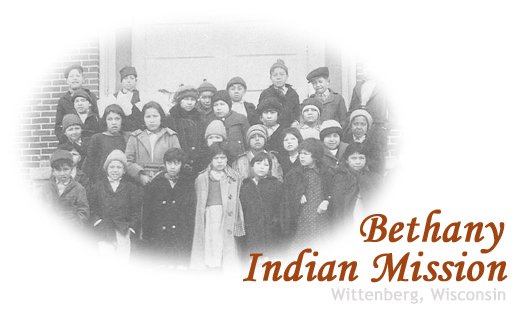
|
| Welcome
to our second page for Indian Schools in Shawano County.
Our first, Red
Springs Indian Mission, explains the Why & Hows of
Indian Boarding Schools and Missions. As we stated
before, these mission schools were controversial at best
and the details sometimes were lost over the years.
We've included articles written in journals, books and
pamphlets as well as school censuses, photographs & post
cards. If you have additional information &
pictures, you can
email me and we can easily update the pages.
And, if you recognize any faces in any of the photos,
email me and we'll add the name to the face.
**NOTE** Some of the
following letters were originally written by the staff
(from their point of view) in order to secure
additional funding from the churches & community.
Please keep that in mind as you read letters & articles
from 1900 - 1920... this was their point of view - not
ours. Why do I include them? They help paint
the picture of what life was like living in the schools as
well as the view that some members of society had...
remember to consider the time period when they were
written.
These Indian Mission
Schools were not just for the children in the immediate
areas -- children from other areas of the county & state
were sent here as well -- including children from the
following tribes:
Brothertown, Oneida,
Menominee, Stockbridge, Winnebago (Ho-Chunk), Chippewa &
Mohawk.
|
 |
|
|
Historical Sketch
of the Bethany Mission
Compiled by Rev. T. M. Rykken (1920)
In endeavoring to give an historical outline of our
Bethany Indian Mission, it is not our purpose to go into
details, but simply to give the main historical facts
interspersed with a few every-day happenings, which we
hope may interest you.
Our Norwegian Lutheran immigrants were a serious and
earnest group of people. They came to this country
bringing with them no money but an indomitable courage;
honesty and upright hearts, and a determination to make
this land of great privilege their home. They brought with
them deep religious convictions and a determination to
spread this most blessed heritage to those less
unfortunate. So it was that in the eighties, when Rev. E.
J. Homme, cutting his way thru the immense woods of
northern Wisconsin, where he proposed to build an orphans'
home, discovered the Red Man wandering about without hope
and without God. He called the attention of Pastors
Larsen, Ruh, and Dahl to the matter, and these men agreed
among themselves to start an Indian mission, and as a
result, 40 acres of heavily timbered land was bought some
four miles west of the village of Wittenberg. This was in
1884. A man by the name of Morstad was placed in charge,
and a log house built to accommodate the missionary and a
few children.
It was no easy task to get a foothold among these
people, as they seemed contented in the immense woods.
There were plenty of wild animals for food and clothing,
and they saw no need of changing. Mr. Morstad endeavored
to learn the Indian language, and succeeded in getting
three or four children into the school; but seeing little
success, he resigned in the fall of 1886. The children
were brought into the Homme Orphans' Home. In the meantime
a suitable building had been erected near the village of
Wittenberg, and 80 acres of land purchased by the
committee before mentioned. Meanwhile the matter of
beginning an Indian Mission had been taken up by the
Norwegian Synod, and the property was now deeded over to
said synod. Rev. T. Larson was called as the first
superintendent, moving from Harmony, Minn., to Wittenberg
in July, 1887, where the building was dedicated and called
Bethany. This was on July 4th, and eight children were
then at school. We find that the first Indian baby was
baptized on this occasion, and that our venerable
President Nordby of the Eastern District was one of the
sponsors.
In the winter of 1888,
Axel Jacobson was called as teacher and assistant to
Superintendent Larson. Meanwhile we discovered that we had
other tribes, more accessible and easier to interest in
educational matters, namely, the Oneidas, Stockbridges,
Brothertowns, Menominees, and Chippewas, some 20 to 40
miles distant from the station. Soon we succeeded in
getting children from these tribes entered in our school,
and our Winnebagoes, for whom we were especially
solicitous, became a little more accessible.
We received support from
the government to the extent of a certain amount until
1895, when all contracts with church schools were
abrogated.
Finding that our school
could not be supported wholly by donations on account of
the attendance having increased, and receiving a
proposition from the government to buy our Mission, the
synod decided to sell the same to the government, which
was done in 1900. Now our mission moved to Ingersoll, 7
miles west, on a large farm, purchased for the use of the
mission. During the years 1893 to 1900 Axel Jacobson acted
as superintendent for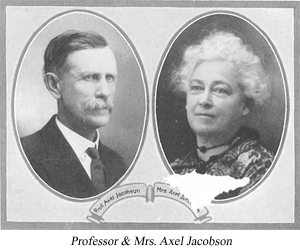 the church and government, and Rev. B. Hovde as mission
pastor. Splendid work for our young Indians was done by
Pastor Hovde in this space of time. From 1900 to 1902 he
acted as superintendent of the Bethany Mission at
Ingersoll. Pastor Hovde resigning on account of old age,
Mr. 0. C. Tosterud was called as superintendent. He held
this position until October 1, 1913, when the mission was
moved back to Wittenberg. The mission board acquired the
Wittenberg Academy buildings, and Axel Jacobson was called
as superintendent. From 1900 to 1907 Rev. 0. A. Strom was
mission pastor at the government school. From 1909 to 1917
Rev. M. C. Waller was mission pastor at Ingersoll, and
later at the mission house at Wittenberg Academy. Thorough
Christian instruction was given the pupils under the
splendid efforts of these men.
the church and government, and Rev. B. Hovde as mission
pastor. Splendid work for our young Indians was done by
Pastor Hovde in this space of time. From 1900 to 1902 he
acted as superintendent of the Bethany Mission at
Ingersoll. Pastor Hovde resigning on account of old age,
Mr. 0. C. Tosterud was called as superintendent. He held
this position until October 1, 1913, when the mission was
moved back to Wittenberg. The mission board acquired the
Wittenberg Academy buildings, and Axel Jacobson was called
as superintendent. From 1900 to 1907 Rev. 0. A. Strom was
mission pastor at the government school. From 1909 to 1917
Rev. M. C. Waller was mission pastor at Ingersoll, and
later at the mission house at Wittenberg Academy. Thorough
Christian instruction was given the pupils under the
splendid efforts of these men.
The mission was run
successfully at the Wittenberg Academy site with an
attendance up to 75 children, until 1917, when the
Government Indian School was closed on account of the war.
The property stood abandoned until 1918, when our Church
repurchased this institution, then much better equipped,
for a small consideration. The former academy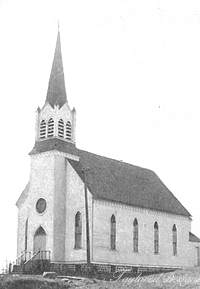 property was
turned into an old people's home. Now we are back at our
first station. Here the mission has prospered the past
three years, and a great blessing has befallen the
Indians. The attendance has varied from year to year,
until at this writing, 139 children are cared for, fed,
clothed, and instructed in all things pertaining to good
citizenship, and, above all, are instructed in that which
pertains to eternal life. We have been fortunate in
securing good Christian teachers each year—teachers who
have been self-sacrificing, and worked solely for the good
of the children. Honorable mention might be made of Alice
Johnson, Oline Lysne, Eureka Jordan (Indian), Magda Hoel,
Marguerite Hovde, and Charlotte Hammer. property was
turned into an old people's home. Now we are back at our
first station. Here the mission has prospered the past
three years, and a great blessing has befallen the
Indians. The attendance has varied from year to year,
until at this writing, 139 children are cared for, fed,
clothed, and instructed in all things pertaining to good
citizenship, and, above all, are instructed in that which
pertains to eternal life. We have been fortunate in
securing good Christian teachers each year—teachers who
have been self-sacrificing, and worked solely for the good
of the children. Honorable mention might be made of Alice
Johnson, Oline Lysne, Eureka Jordan (Indian), Magda Hoel,
Marguerite Hovde, and Charlotte Hammer.
The work is very encouraging now. The Indians are
really very interested in it themselves. It is far
different from what it was during the first years. In the
earlier days we would travel day and night, week after
week, trying to induce the old Indians to send us their
children, whereas now the children are brought to our
doors. There was a time the medicine men would come and
give this instruction: "You may take my children and teach
them to read and write, but I will tell them about God"
(none wanted to see their children baptized or confirmed)
; now they are, as a rule, very anxious to have their
children baptized and instructed for confirmation.
To refute the assertion often made, even by educated
people, that it is an impossibility to fully civilize and
Christianize a heathen in the first generation, let me
narrate the following :
It was back in the nineties, some years after we had
started our Indian Mission. Those were different days. It
was next to impossible to get the Winnebagoes to send
their children to our school. I took regular trips out to
the different camps, pleading with the old folks to send
their children to school. Old man Bear, a typical,
full-blooded Indian, had a good looking boy named Tom, who
was about nine years old. After pleading at intervals,
whenever occasion permitted, during almost a year, we
succeeded at last in getting the boy into our school. I
recollect as if it were today that stalworth Indian
appearing at the school, with this bright, black-eyed boy,
clad from top to toe in buckskin clothing, and his cue,
nicely braided, hanging down the back of his head. (All
these Indians, men and boys, wore the cue. The old
superstition was still in force that a man who had lost
his cue, in other words had been scalped, would never
enter heaven, the happy hunting grounds.) Now came the
crucial test. All our boys must bathe, change clothes, and
have their hair clipped on the day of admittance. I
personally took Tom, after the father had left, down
beneath the maple trees, and clipped his head close, cue
and all. After this I had him remove his buckskin clothes
and don others. I carefully wrapped the buckskin suit in a
bundle to have it ready for the father when he should call
for it. The next morning Mr. Bear came. Tom was getting
his first start, and in came Mr. Bear. One sharp glance at
the boy and another at me, and I felt as tho I were
pierced thru by it. I shall never forget that look. Coming
closer to me, he made signs by pointing to Tom's head and
clothing. I understood what he wanted, and made signs for
him to sit down until I let the pupils out for recess.
Recess came, and I beckoned to Mr. Bear to come with me,
and I would get the buckskin clothing. When the bundle was
handed him, he made me understand that he was pleased with
that, but yet he pointed to his head. Then I thought of
the cue. We proceeded down the side hill to the maples. He
carefully picked up the cue, wrapped it in the bundle with
the clothes, and departed.
Tom stayed at our school
constantly. Peculiarly enough, he never asked for
permission to leave the school and go home, even on a
visit. A singular case. The father came to see him often,
and I sometimes felt sorry for the old man when Tom
refused to go home with him. Tom was interested in his
studies, also joined our small school band, where he
played the "E flat" bass horn. I heard it expressed by a
good musician, "Tom has us all beat; he plays 'Rocked in
the Cradle of the Deep' much better than a white man."
Tom learned to know what
Christ had done for him, and was baptized and confirmed at
our school. When thru here, he went to the Carlisle Indian
School, making a splendid record. At the outbreak of the
Philippine War, he was sent as leader of a small military
band, and stayed two years. He was honorably discharged,
appeared at our office one day, and was exceedingly glad
to be back here. The first he said was, "Mr. Jacobson,
your mission school has brought me the greatest blessing
in my life. The things taught me here, viz, what Christ
did for me, and what He expects of me has been my guide so
far. I now want to take up a course in your academy, and
see if I cannot do something for my people that they too
may see the light."
Tom entered our academy,
but God willed it otherwise. He was taken sick and died.
During his sickness our pastor visited him, and gave us
the assurance that Tom died a believing Christian. The
principal of our academy made the statement, "Tom was the
most orderly, prompt, and well behaved student at the
academy."
Many other instances
might be related.
From the time our mission
was started up to the spring of 1920 we have baptized 351
infants and adults. We have confirmed 142, and have had
425 attendants at communion.
God has opened the door.
We have now splendid quarters, and room for some 50 or 60
more than we have at present. We have also received
applications for more than this number, but where are our
means? We need beds and bedding, school desks, and means
to support these unfortunates.
When we think back to the
time we began the work here, and think of the obstacles
confronting us, and how different the attitude of the
average Indian to our mission is now, we must wonder and
exclaim, "Blessed be the Lord God, the God of Israel, who
only doeth wondrous things" (Ps. 72:18).
As God has opened the
door for us, will not you, kind reader, with prayer and
gifts do your part to the end that our work may be
enlarged, and all these young may be admitted into our
mission, and become a salt among the remaining people who
still live in darkness?
Will not you, out of the
abundant blessings which, in a way, you have inherited
from the Indian, in the lands and possessions left you,
share in assisting him to become partaker of the spiritual
blessings you possess?
Consider for a moment:
there are 300,000 Indians in the United States, and only
one Norwegian Lutheran mission, and one German Lutheran
mission among them.
Shall we whose
souls are lighted
With wisdom from on high
Shall we to men benighted
The lamp of life deny?
Shall we who know the Law
to be our schoolmaster to drive us to Christ, and Christ
the propitiation for our sins, which knowledge impels us
to be the children of God, zealous of good works, shall
we, I ask, deny these our Christian fundamentals to the
heathen directly before our doors?
Hoping this little
pamphlet may in some measure increase our interest in the
salvation of the Indian, I am Fraternally,
Axel Jacobson
Wittenberg, Wis., March 16 (1920) |
|
|
 |
Lutheran
Mission Work Among the American Indians (1922)
Chapter VIII
THE BETHANY INDIAN MISSION OF THE NORWEGIAN CHURCH
It was in 1883 that the Norwegian Synod, now merged in the
Norwegian Lutheran Church, acting on the appeal of Rev.
Tobias Larsen, decided to begin missionary work among the
Indians of Northern Wisconsin. In order to obtain concrete
results it was proposed to establish a school for Indian
children near Wittenberg in Shawano Co. However, more than
a year passed before the mission board was able to extend
a call to Eric O. Moerstad, who arrived on the field
September 30, 1884. He was directed to a certain George
DeCora, an Indian who might aid him in acquiring the
language. "This Indian had discarded his red blanket, was
dressed like a white man, and lived in a small log house.
He spoke fluent English. The missionary was welcomed by
him, and the two were soon busily engaged in preparing a
list of words and expressions in the Winnebago language.
Mrs. DeCora made dinner for them. An old oilcloth was laid
on the floor, as there was no table. Nor were there any
chairs, and dinner had to be eaten as conveniently as
possible seated on the floor. The meal consisted of pork,
potatoes, bread and butter, and tea with sugar. It was
relished by the partakers, and showed marked improvements
in civilization."
Three and a half miles west of Wittenberg, where several
families of the Winnebago tribe resided, forty acres of
land was secured, and a mission station, receiving the
name Bethany, was soon in course of construction. Into
this modest building, 18x26, four little Indian boys were
received and made comfortable. In spite of this, the
temptation for these boys to return to their kin was
great. At the same time, Indians as well as unscrupulous
whites tried to hinder the work in every conceivable way.
As usual in such cases, the missionary was represented as
a dangerous man. Among other things, it was claimed that
every family from which children attended the mission
school would lose fifty dollars of its annual Government
allowance. Here also, as in the case of the Bethany
Mission in Michigan, the story was circulated that
children would be sent across the ocean and never return.
But these slanderous statements had little effect.
In September, 1885, the Indian mission board held a
session at Wittenberg and naturally also visited the
mission station. There they were received by Mr. Midtbo
and family, which seems to indicate that Rev. Moerstad no
longer had to attend to household duties. After due
deliberation it was decided to make further improvements
in order to accommodate the Indian boys who presumably
would attend the school during the coming winter. Already
before, the building had been enlarged by a frame
addition, and now the roof on the part built of logs was
to be raised in order that the attic might serve as
sleeping quarters for the boys. It was furthermore decided
to build at Wittenberg and to expand the work, the report
stating that "we must do something for the Indians, so
much the more as we now have the consent of the Government
to receive children also from other parts, especially the
Stockbridge and Oneida reservations, as well as to carry
on the work in general.''
For a consideration of eight hundred dollars eighty acres
of land was bought for the new station during the winter
of 1886. In the spring and summer this land was cleared of
boulders, timber, and underbrush. A well, which provided
excellent water, was also dug. However, in the fall of the
same year, Rev. Moerstad, who previously had asked for his
release, and whom we shall meet again as a missionary to
the Pottawatomies, left the station. It was now deemed
best to discontinue the work at the old location, the six
remaining Indian children being temporarily cared for at
the Homme Orphans' Home at Wittenberg. The building and
the forty acres of land, now partly cleared and
cultivated, were bought by Mr. Midtbo, the steward.
Building operations on the new site progressed rapidly,
the first structure with the respectable dimensions of
28x72 and 28x60, having basement, two stories, and an
attic, being finished during the first half of 1887. On
July 4th this Bethany Indian Mission and Industrial School
was solemnly dedicated. Thus the mission had found a
second and more commodious home for its work among the
Indian children. Including the land, the property
represented a value of six thousand dollars. A new
superintendent was secured in the person of Rev. T.
Larsen, who with two teachers and other employees entered
upon his new duties on the day of the dedication of the
mission. This force was augmented in the following year by
the appointment of Axel Jacobson as teacher and assistant
superintendent.
At the beginning eight children were in attendance, but in
August this number was increased by twelve from the Oneida
tribe, while in November an additional twelve swelled the
total to thirty-two. Soon an important event made possible
another increase. For on January 1, 1888, a contract was
entered into with the United States Government for the
support of twenty-five children. This contract was renewed
from time to time, the number of Government supported
children being gradually increased. Thus in 1894, for
instance, it provided for one hundred and fifty children.
These were generally drawn from different tribes, in 1894
being divided as follows: Oneida ninety-nine. Stockbridge
thirty-two, Brothertown ten, Winnebago five, Chippewas
ten, Mohawks three. By securing children from different
tribes, the work of education and civilization was greatly
aided, as the children were thus forced to desist from
using their native dialect in play and conversation. The
financial support granted by the Government, however, was
inadequate, as the Government schools received for their
children about twice the amount of that of the contract
schools.
This partial control by the Government did not affect the
religious life in any marked way. Practically the only
restriction was in the use of denominational text books,
but this could be made good thru verbal instruction. Each
day the children were taught the fundamentals of the
Christian religion, they had their morning and evening
devotional exercises, and on Sundays attended the regular
service.
Besides the usual subjects, work of a vocational nature
was also taken up. "Since the Allotment Bill of 1887
entitles the Oneidas and Chippewas to a piece of land
individually on their respective reservations, some time
is spent in giving the boys instruction and practice in
farming and clearing land. The work progresses slowly, but
at times it is interesting to listen to the young fellows'
plans and devices as to their future home, on which Uncle
Sam in time awards them a deed. There is also an
opportunity for those who wish to learn carpentry,
painting, smithery, etc."
On account of failing health Rev. Larsen had relinquished
the superintendency in 1893, being succeeded by Axel
Jacobson, who occupied that position till 1895. In that
year congressional action made a radical change necessary.
A bill was passed which reduced the contracts 20 per cent
each year, so that in 1900 all support would be withdrawn,
tho Indian treaty and trust funds could still be used. As
in 1895 the attendance had reached the number of one
hundred and forty, the synod was unable to operate the
Bethany Mission on such a large scale. So it was finally
agreed to sell the entire property to the United States
Government, which was to continue the school. The
superintendency of the Government institution was offered
to Axel Jacobson with the understanding that the old
teaching force be retained. Mr. Jacobson accepted and held
the position as superintendent of the school and agent for
the Winnebago tribe from 1895-1905, when he resigned to
take a long deserved rest after eighteen years of
continuous work among the Indians.
The Norwegian Synod decided to continue the mission on a
smaller scale at a suitable location, where, it was
thought, the children would be afforded better opportunity
to receive industrial training of the kind they needed.
The Ingersoll farm, located seven miles from Wittenberg,
was bought, and in July, 1900, the Indian Mission moved
into its new home and was continued independently of the
United States Government.
As a superintendent of the mission Rev. B. Hovde was
appointed, being succeeded after his retirement a few
years later by Mr. O. C. Tostrud, an experienced teacher,
who with the help of his devoted wife achieved
considerable success. The number of children during this
period was of course far smaller than at Wittenberg,
ranging from twenty-five to fifty, mostly of the Winnebago
tribe. They did not remain during the whole year, as had
been expected, but arrived late in the fall and left
during May. Thus the plan of having the Indian children
work on the farm during the summer could not be realized.
Neither was the operation of a large farm in connection
with the mission a very paying proposition. One can
imagine the trying time of the superintendent, who had to
manage both the farm and the mission. He was forced to do
the greater part of the teaching and assist in the farm
work, while all the other duties of the double position
rested upon his shoulders. Among these were marketing,
trips to secure children and to bring them back when they
ran away, which not seldom happened.
However, the location was not a very good one. The nearest
railroad stations were Eland Junction, four miles, and
Wittenberg, seven miles distant. This involved
considerable labor and much inconvenience. The spiritual
needs were looked after by Rev. M. C Waller, who conducted
divine services at the mission every third Sunday during
the school year. All baptisms, confirmations, and
communion services also took place at Ingersoll instead of
at the church in Wittenberg.
The handicaps of the location were found increasingly
embarrassing, so finally, in 1912, a committee was
appointed charged with the duty to visit Ingersoll
together with the Indian mission board. It was to report
back to the synod the results of its investigation,
especially in regard to the advisability of moving the
mission to some other place. On the strength of the report
made by this committee, the general convention was
petitioned to sell the Ingersoll farm and to move the
mission to some city, preferably Wittenberg. The
recommendations of the board were adopted, and in the fall
of 1913 the mission was back once more in Wittenberg,
where the entire property of the Wittenberg Academy
Association had been bought for Indian mission purposes.
Prof. Axel Jacobson was now called to the superintendency,
and under his able administration the Bethany Indian
Mission has enjoyed a healthy growth. The whole movement
received a great impetus when the newly formed Norwegian
Lutheran Church authorized the repurchase of the original
Bethany Indian Mission site, so that the school is now
located at its old quarters, A number of valuable
improvements had been made during the Government
ownership. The deal, involving property estimated at
$65,000, was concluded in January, 1919.
At the well appointed quarters at Wittenberg, the
attendance has steadily increased. For some years it
ranged from fifty to seventy, but lately the one hundred
mark has been passed. During the latter part of 1919 there
were 120 children in the school, with an additional one
hundred applications on file. This year, 1920-21, has seen
the largest attendance in the history of the school, 140
being enrolled. These are mostly from the Winnebago and
Oneida tribes. There are eighteen members in the
confirmation class, and twelve children are likely to be
baptized. Since the beginning of the Bethany Indian
Mission there have been 363 adult and infant baptisms, 142
have been confirmed, and 425 have communed. In the school
the common branches are taught; in addition religious
instruction is given, the children being divided into
convenient groups for that purpose. But not only does the
mission furnish instruction, but also food and lodging,
and to a considerable extent also clothing.
Among the older Indians in the settlement considerable
progress has been made. Services are held every Sunday
afternoon, and the attendance is fair. A number of adult
baptisms have also taken place of late. Furthermore, the
work has been extended to the Indian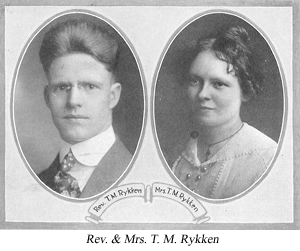 settlements near Wittenberg, services being held at the
Bethany Indian Church at Embarrass River. The children and
others are also somewhat assisted as to clothing,
especially during the coldest part of the winter. Rev. T.
M. Rykken, of the 1920 class from Luther Theological
Seminary, devotes his time exclusively to Indian
missionary work.
settlements near Wittenberg, services being held at the
Bethany Indian Church at Embarrass River. The children and
others are also somewhat assisted as to clothing,
especially during the coldest part of the winter. Rev. T.
M. Rykken, of the 1920 class from Luther Theological
Seminary, devotes his time exclusively to Indian
missionary work.
When more than thirty years ago the missionaries began
work among the Winnebagoes in the forests of Wisconsin,
the Red Man paid only slight attention to them. No
material want existed then, for there was an abundance of
deer in those days, deer hunting being the main source of
sustenance for the Indians. Every one was then dressed in
buckskin, and quite often the wigwams were also covered
with the same material. In winter it was a common sight to
see one or more carcasses of frozen deer hanging outside
of the wigwam. Before the first fall hunt a dance lasting
one or two days was held, when by speeches and
supplications they implored divine blessing for the first
hunt
These Indians, happy and contented, were entirely deaf and
indifferent to the pleadings of the missionaries to send
their children to school. As hunting became poorer and
want made its presence felt, a gradual change took place.
A few children began attending school, and reading and
writing came to be looked upon as a good thing. But when
it became known that the children received instruction
about the Triune God, there was violent objection from the
medicine men, of which the tribe of fourteen hundred had
about seventy-five.
In course of time, however, a great change also appeared
in this respect, and very gratifying results in the
Christianization of the Indians were secured.
Superintendent Jacobson narrates one instance which tends
to destroy the fallacy that one cannot civilize or
Christianize a heathen in the first generation. "I have in
mind a Winnebago boy, a relative of Bighawk the chief. I
tried and tried for a couple of years back in 1888 or 9 to
get the father to send him to school. He was a bright
looking lad about eight years old, clad in buskskin from
top to toe, also wearing the long cue down the back of his
head. One day I succeeded in getting him into school. I
took him below to the laundry building, clipped his hair,
and dressed him up in white man's clothing. The next day
the father appeared, looked at the boy in a surly manner,
and eyed me in no more lovable style. At last he pointed
to where the cue had been and also made signs as to the
buckskin clothing. I walked along down to where I had
clipped the hair, and the old man carefully hunted until
he found the cue of hair, and after carefully wrapping
this up in the buckskin clothing, he left satisfied. The
unexpected happened. The boy stayed right here at the
mission, learned to play the E-flat bass horn in our
Indian brass band better than any white boy, was baptized
and confirmed. He was a real Christian spirited boy. We
sent him to the Carlisle Indian School for further
training. While there the Spanish American War came on,
and Thomas Bear and another boy, Albert Thunder, left for
the Philippines as United States soldiers, Thomas as
leader of the regimental band. After serving two years he
was honorably discharged and came back here to take up a
course in our Lutheran Academy. Thomas was taken sick of a
spinal disease and died at the academy a true Christian.
The principal of the school gave him the testimony of
being the neatest, best behaved, and Christian spirited
boy at the academy, where he was the only Indian."
How different and in many respects easier is not the work
now than it was thirty years ago. Then the workers had to
scour the country for weeks, mostly on foot, and how they
rejoiced if only one child was entrusted to their care.
Now the parents bring them to the mission without any
solicitation and beg the superintendent to teach them
about the true God and Christ the Savior. When the
medicine men still held perfect sway, the parents on
hearing that their children were taught religion at the
mission school rebelled. The teaching of such useful
things as reading and writing they permitted, but
considered themselves and their medicine men alone
competent persons to give instruction concerning the Great
Spirit. At the present time the situation is entirely
changed. Only about three to four hundred are still
clinging to the old beliefs, while the others believe with
varying strength in the Triune God, who speaks to men thru
His inspired Word. The influence of the few remaining
medicine men is fast waning. Thus Bethany Indian Mission
under the guidance of its enthusiastic superintendent is
permitted to perform its great work without let or
hindrance.
|
|
 |
The following information was
written by two students of the mission school - these would
have been submitted to the parent church office to show the
"success" of the mission and reasons to continue its support.
|
What the
Bethany Indian Mission Has Done for Me
My name is Harry Thunder. I am a Winnebago Indian
boy, 17 years old. This is my second year at the Bethany
Mission. Before coming here I spent two years at a government
Indian school. Although I learnt many things at that school,
it did not do nearly so much for me as the Bethany Mission has
done for me.
I had not stayed long at this school before I noticed that the
spirit of the school was different. At the former school we
obeyed thru fear of punishment. Here we are taught to obey
because it is God's desire that we should do that which is
right.
I did not feel so much at home in that school as I do in this one.
Here we have Christian people to care for us and teach us. I
am very thankful to the mission for this.
But my greatest reason for liking this school is that here I was
taught to love Jesus and to believe that He is my Savior who
has redeemed me. The Government School never mentioned these
things. At this school we hear the Word of
God every day, and sing
hymns of prayer and praise to Him morning and evening.
During the first year that I was here I was taught the Word of God,
and I was very interested in learning it. I had never seen a
Catechism nor an Explanation before I came here. After having
received instruction thru the year, I was baptized and
confirmed. I shall never forget that day. It was the greatest
day for me. I am very glad that I came here, and that I have
learnt to know and believe in my Savior.
This year I am taking Bible study. I find it very interesting and
beneficial.
I am in the eighth grade, and I enjoy the work very much. If
I can finish my grade this year, as I hope to, I plan to take
up further study next year.
It is my wish to become a missionary among my people. There are so
many of them who have not heard the Word of God. They have not
heard of Jesus Christ coming into this world to suffer and die
for us, in order that we might obtain eternal life thru faith
in His merits. They serve strange gods instead of the one true
God. They pray to rivers and lakes, animals, trees, and many
other things. Because of this their home life is often
miserable and pitiful. It would be so different if they could
learn about Jesus, and accept Him as their Savior, and be
willing to serve Him.
I hope that this school will always continue its work so that many
other boys and girls may have the opportunity to come here and
study the Word of God, and learn to live as they should.
Harry Thunder |
|
My name
is Stella Hill. I am an Oneida Indian girl,
14 years old. I have attended school here at the Bethany
Mission for some time. I like it very well at this school. We
are made to feel right at home here, and that makes it so
pleasant. There are not so many children here as at some
government schools, where they often have over 300 boys and
girls. That helps us to get better acquainted, and we feel
like brothers and sisters. Here we go to school all day. At
the government schools it was always half days at school. I
like it better this way, for we learn so much more.
The teachers and the matrons mean a great deal to me, because they
are Christians, who teach me the love of God. They tell me to
do that which is good, not because we shall thereby escape
punishment, but because we are God's children. If we really
love Him, we like to do that which is His will.
The government schools were good in that they taught us how to
read, write, work problems in arithmetic and such common
studies. But we are taught that here too, and besides that we
have an hour of religious instruction every morning. Here we
have confirmation class too, and a class in Bible study. We
have devotion every morning and evening. We learn to sing
hymns out of the Lutheran Hymnary, hymns which really mean
something.
We also have services in our little church on the Mission Hill
every Sunday. We have h choir that sings every Sunday. These
things we could not have at the government schools.
Since we know that the kind people of our Lutheran Church pray for
us, it makes it easier for us to do that which is good.
All these things make me feel very grateful to the mission. It is
my wish that I in time may do something for the mission, by
doing something for my people, to show that what the mission
has done for me has not been done in vain.
Stella Hill. |
|
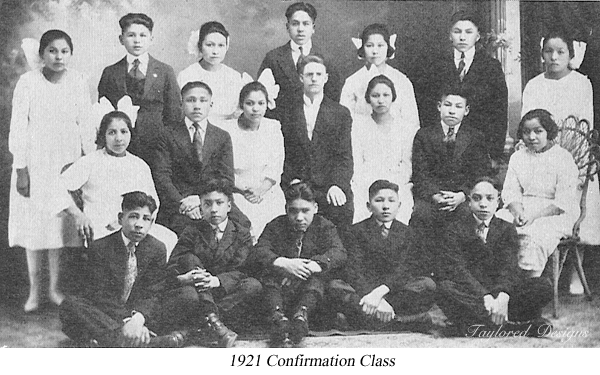
If you can identify any of these
students, please email me so we can update the page.
Thanks...
|
|
1921
Bethany Mission School Enrollment
|
|
louise archiquette |
margaret archiquette |
|
pierce baird |
lucy boyce |
|
liaila boyce |
edith blackhawk |
|
philip blackhawk |
harold buchanan |
|
marie badsoldier stacy |
mitchel badsoldier stacy |
|
rebecca badsoldier stacy |
lena bigthunder |
|
elmer bigthunder |
jeremiah bigthunder |
|
adelaide blackhawk |
mayme coulon |
|
catherine coulon |
amelia coulon |
|
howard coulon |
jacob coulon |
|
virginia coulon |
paul christjohn |
|
marie christjohn |
rose cloud |
|
lucy carimony |
allen carimony |
|
annie dick |
venvorth dick |
|
grendall dick |
dora decorah |
|
eva decorah |
helen decorah |
|
wanda decorah |
ernest decorah |
|
mitchell elm |
mabel elm |
|
james funmaker |
george funmaker |
|
daniel funmaker |
elsie green crow |
|
annie green crow |
mary green crow |
|
george green |
victor hill |
|
george hill |
estelle hill |
|
romona hill |
katherine hill |
|
margaret house |
vera house |
|
leonard hopinkah |
adam hall |
|
william hill |
brownell hill |
|
josephine hill |
isador john |
|
jasper john |
elizabeth john |
|
howard john |
reno john |
|
flora king |
julia king |
|
lawrence kirkwood |
stephen kirkwood |
|
minnie littlewolf |
sam littlesoldier |
|
edmund lincoln |
edward lonetree |
|
fred lonetree |
leola lyons |
|
neoma lyons |
beatrice lyons |
|
merrill lyons |
rudolph lyons |
|
chester mallory |
ruth mallory |
|
daniel mallory |
jesse mike |
|
thomas mike |
dora mallory |
|
malinda nynham |
george nynham |
|
electa powles |
agnes powles |
|
oscar pigeon |
sarah pigeon |
|
frank pigeon |
loomis peters |
|
agnes payer |
minnie payer |
|
sarah payer |
ruth payer |
|
ferdinand palladeau |
daniel rockman |
|
mildred rockman |
ada stacy |
|
lena summers |
sada summers |
|
hattie summers |
raymond summers |
|
wilmae sickles |
lester smith |
|
isabelle smith |
casteson swamp |
|
evelyn swamp |
lucy stevens |
|
shalton stevens |
john stacy |
|
frank storm |
john storm |
|
antone stevans |
henry stevans |
|
clayton skenandore |
leo skenandore |
|
lucile thomas |
joseph thundercloud |
|
oline thunder |
harry thunder |
|
lena white pine |
josephine white pine |
|
raymond whitewing |
lowell whitewing |
|
martha whitewing |
frank wabshagain |
|
herman wabshagain |
lena wabshagain |
|
earl williams |
joseph williams |
|
nancy williams |
sarah white |
|
mike white |
evelyn white |
|
david white |
amelia webster |
|
angeline webster |
fred white eagle |
|
jesse white eagle |
howard walker |
|
amelia wilson |
fanny wilson |
|
|
|
 |
|
|
|
|
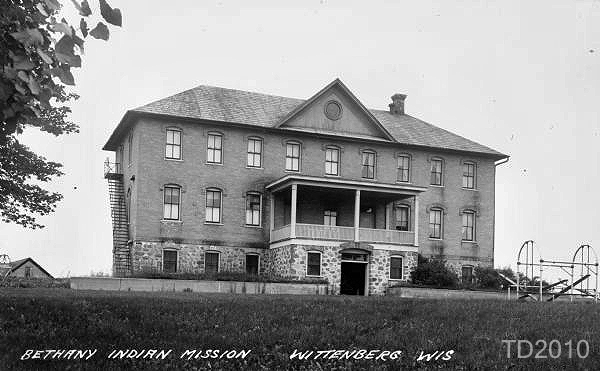 |
|
|
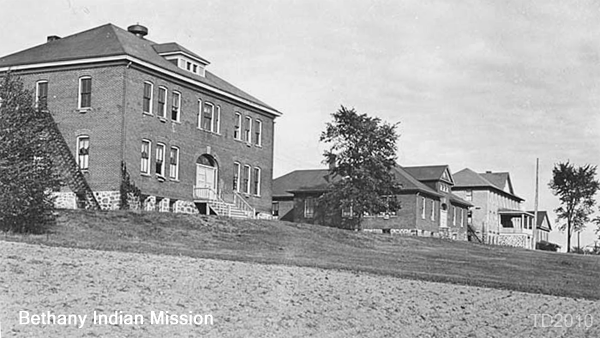 |
|
|
|
 |
|
Now, here's some good stuff --
not only do some of the censuses list the student, some also
list the tribal affiliation and blood quantum... and there's a
few of their original Native American names included as well.
Click here. |
|
 |
|
We generally post queries to the
Message Boards & surnames to the Surname page... but...here's
a place to connect with other people who had family in the
Bethany Indian School Mission area. Just send me your
info and I'll gladly post it... hopefully you'll make a
connection! |
|
Student or Family Surname |
Tribal Affiliation |
Researched By: |
|
ADD YOUR
NAMES |
|
|
|
ADD YOUR
NAMES |
|
|
|
ADD YOUR
NAMES |
|
|
|
ADD YOUR
NAMES |
|
|
|
|
|
|
And, if you have
anything else you would like to share, please send us an
email. |
|
|
 |
|
© Taylored Designs 2010
All Rights Reserved. |
|
|
|
|
|